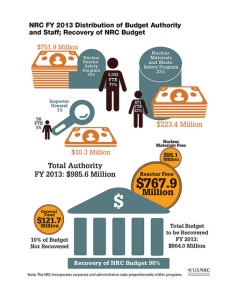It happens near the end of every summer – the NRC’s final fee rule is implemented. This year’s effective date is August 29, 2014. What does that mean? The final rule establishes the fee policy for fiscal year (in this case FY 2014, which ends Sept. 30th). It’s prepared in response to public comments on the proposed rule and final fee amounts in compliance with the Omnibus Budget Reconciliation Act of 1990, as amended.
 For FY 2014, the NRC’s budget is approximately $1 billion. Based on this amount, the NRC will recover about $916.7 million by collecting fees. About 36 percent of the fees are attributed to licensee-specific services (such as services done by NRC staff for a particular licensee) and 64 percent from annual fees collected from all licensees.
For FY 2014, the NRC’s budget is approximately $1 billion. Based on this amount, the NRC will recover about $916.7 million by collecting fees. About 36 percent of the fees are attributed to licensee-specific services (such as services done by NRC staff for a particular licensee) and 64 percent from annual fees collected from all licensees.
The law requires the NRC to recover about 90 percent of our budget through fees, which means the agency is only funded about 10 percent from taxpayer money.
There are two types of fees the NRC charges. One is an hourly rate and flat application fees, and the other is an annual fee. Both types of fees recover the costs of regulating the use of radioactive materials. Hourly fees recover the costs of providing specific services to individual licensees (or potential licensees) such as reviewing applications and performing inspections. Annual fees recover all costs associated with regulatory activities, such as rulemaking and research, which benefit all licensees.
The final rule includes several changes from FY 2013. First, we are changing the current hourly rate from $272 to $279. Secondly, we are revising the flat license application fees (found in our federal guidelines 10 CFR Parts 170.21 and 170.31) to reflect the new hourly rate.
And, finally, we are revising the annual fees to recover the costs of providing regulatory services that benefit all classes of licensees. The annual fees increase for operating reactors, research and test reactors, most fuel facilities, material users, and uranium recovery facilities. Annual fees decrease for spent fuel storage facilities (at operating, decommissioning and decommissioned reactor sites) and Department of Energy transportation activities.
For more details on the final rule, please visit www.regulations.gov and use Docket ID NRC-2013-0276. For FY 2014 budget information, go here.

Q. What about NRC fines and/or penalties?
A. Proposed: All fines and penalties go directly to the U.S. Treasury.
Q. What is the amount that the NRC collected the last few FY’s?
A. The NRC will collect $916.7M in FY 2014. For other years, $859.6M in FY 2013, and $901M in FY 2012 in fees assessed to applicants and licensees.
Q. Where does this money go, operating costs or ?
A. All money collected goes back to the U.S. Treasury.
Arlette Howard
Q. What about NRC fines and/or penalties?
Q. What is the amount that the NRC collected the last few FY’s?
Q. Where does this money go, operating costs or ?
It is time for every group that requests a licensing-related change in the operation of a licensee to post a bond for the estimated cost of the hearings, reviews and meetings that the NRC estimates will be required to cover its costs. If the initiator of the appeal wins, its fee will be returned in full plus interest. If the Appeal is denied or lost, any unspent portion of the estimate would be returned. The rest would remain in the NRC’s account.